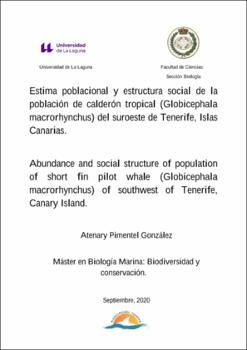Estima poblacional y estructura social de calderón tropical (Globicephala macrorhynchus) del suroeste de Tenerife, Islas Canarias.
Author
Pimentel González, AteneryDate
2021Abstract
El suroeste de Tenerife es un reducto de biodiversidad de cetáceos único en el mundo, en el
que se encuentra una de las pocas colonias residentes de calderones tropicales (Globichepala
macorhynchus) descubiertas en el mundo. Esta comunidad se encuentra en una de las áreas con
mayor impacto turístico y recreativo de la isla, lo que puede afectar directamente al estado de
salud de esta comunidad. Para valorar el estado de salud de estos calderones, se llevaron a cabo
análisis de estimas de abundancia, en MARK, generales y por años, considerando el total de los
calderones como los que presentan mayor afinidad por el área: “residentes”. Se llevo a cabo
también un análisis de estructura social, en SOCPROG2.9, de la población residente del área,
demostrando que presentan unidades sociales estables y duraderas, con cierto grado de
disociación. Por último, se analizaron como indicadores de natalidad: el porcentaje de grupos
con crías y juveniles y la media de crías y juveniles por grupo, comparando la población del
suroeste de Tenerife según su grado residencia con una población control: Anaga. Estos
indicadores de natalidad mostraron que la comunidad de calderones residentes del S-O de
Tenerife está viendo disminuido su potencial reproductor, lo que parece estar relacionado con
las actividades náutico recreativas que se llevan a cabo en la zona de forma masiva. The southwest of Tenerife is a unique bastion of cetacean biodiversity in the world, where
one of the few resident colonies of pilot whales (Globichepala macorhynchus) discovered in the
world is found. This community is located in one of the areas with the greatest tourist and
recreational impact on the island, which can directly affect the health status of this community.
To assess the health status of these pilot whales, an analysis of abundance estimates was carried
out, in MARK, general and by years, considering the total of pilot whales as those with the
greatest affinity for the area: "residents". An analysis of social structure was also carried out, in
SOCPROG2.9, of the resident population of the area, showing that they present stable and
lasting social units, with a certain degree of dissociation. Finally, the percentage of groups with
offspring and juveniles and the average number of offspring and juveniles per group were
analyzed as birth indicators, comparing the population of the southwest of Tenerife according
to their degree of residence with a control population: Anaga. These birth indicators show that
the pilot whale community residing in the SW de Tenerife is seeing its reproductive potential
diminished, which seems to be related to the recreational nautical activities that are carried out
in the area on a massive scale.




